CASE STUDY • ABSTRACT

30+% Decrease in Cost Per Lead

28% Increase in Leads to Conversion

33% Reduction in Failed Media Tests
CASE STUDY
CASE STUDY
The Impact of Personality Profiles on Marketing Campaigns
Abstract
Historically, companies rely on customer surveys to produce consumer data. This data consists primarily of age ranges, gender, HHI, education, family members, etc., and is generally beneficial when creating marketing campaigns. The purpose of this test was to explore the potential benefits of identifying customers by personality types and employing that data to refine marketing strategies. The collection method employed utilized a new behavioral technology that analyzes a facial image (selfie) and processes that image through phenotype and genotype databases, which have been validated for over 30 years. The facial image analysis was processed through two clinically proven personality inventories (Big 5 and DISC) and validated by a Doctor of Psychology.
The test was designed to reveal if greater campaign success could be achieved by:
(a) Identifying and matching customer personality types to audience personality types
(b) Enhanced insights into ad creative directed to specific personality types
The Impact of Personality Typing on a Nutraceutical Client
The ADcology agency had been working with a top 5 nutraceutical brand in TV, podcast, and radio for 18+ months prior to commencing this test (BASELINE). ADcology's AI technology scrubbed 112 verified customers from the client's social media and (anonymously) processed them through their behavioral platform. It should be noted that customer personality patterns emerged around the 50-processing mark and were solidified by customer #81. The study clearly identified that 74%+ of these businesses' customers fit into (2) two dominant personality types. Learnings included: introversion/extroversion scale, agreeableness, compassion, curiosity, avoidance, conscientiousness, learning styles (visual, auditory, video, and print), bias (negativism and optimism) speech preferences, social engagement, vocabulary levels, and most likely to be influenced by endorsements.
Results
Once compiled, the businesses' personality profiles were matched against audience personality profiles and shared with creative script teams. In every area of measurement, deep personality insights into verified customers, when matched with corresponding media, overwhelmingly led to positive and more profitable campaigns in every measurable metric.